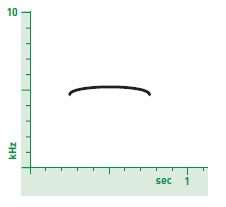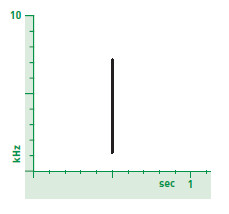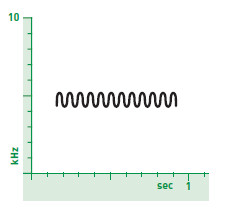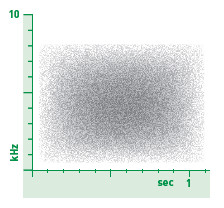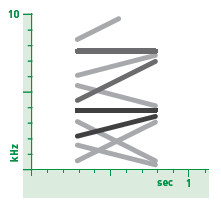The seven basic tone qualities
(Peterson Field Guide to Bird Sounds, interactive version of pp. 14-15)
The distinctive voice of a bird sound, also called its tone quality, can be an important clue to its identification. Many species have unique tone qualities, and although the differences are easy to perceive, many people have found them difficult to descibe. However, all bird voices are composed of variations or combinations of just seven basic tone qualities, illustrated below and explained in more detail on the following pages.
Whistled sounds
Whistles are the most basic sounds, appearing on the spectrogram as simple nonvertical lines. Examples include typical human whistling and the sounds of flutes and piccolos. Birds with whistled songs include Black-capped Chickadee, Yellow Warbler, and Northern Cardinal.
Hooting and cooing sounds
The hoots of large owls and the coos of doves are just extremely low-pitched whistles, less than 1 kHz in frequency. Because they are so low, they are illustrated in special spectrograms with a vertical scale of just 0 to 2 kHz. These low-pitched spectrograms are marked with an owl symbol.
Ticking sounds
Instantaneous bursts of noise sound like ticks, snaps, or knocks, and appear on the spectrogram as vertical lines. The ticking of a clock, the drumming of a woodpecker’s bill against a tree, the bill snap of an angry flycatcher, and the ticking song of Yellow Rail all fall into this category.
Burry and buzzy sounds
When a sound rises and falls very rapidly in pitch, it forms a squiggly line on the spectrogram and sounds trilled, like a referee whistle. If the squiggles are tall and fast enough, they sound less musical, more like an electric buzzer. These sounds are common among birds such as warblers and sparrows.
Noisy sounds
Noisy sounds contain noise—that is, random sound at multiple frequencies, which looks like television static on the spectrogram and sounds like static to the ear. Very noisy bird sounds have a rough or harsh quality, like the alarm chatters of wrens and the hissing of angry swans and geese.
Nasal sounds
Nasal sounds are composed of whistles stacked vertically that the human ear interprets as a single sound. Examples include police sirens, the whine of mosquito wings, and the sounds of oboes and violins. Birds with nasal voices include Red-breasted Nuthatch, Black-billed Magpie, and Pinyon Jay.
Polyphonic sounds
Birds can make two whistled or nasal sounds simultaneously, creating a distinctive sound with a spectrographic pattern of lines that cross and/or stack without exactly matching. Such sounds may be dissonant and “whiny,” like the calls of goldfinches, or metallic, like the songs of many thrushes.
Combinations
These seven tone qualities interact and combine in various ways. A few of the
more common combinations are listed here.
- Nasal and noisy sounds include shrieks and screeches.
- Nasal, noisy, and burry sounds include the caws of crows and the quacks of
ducks. - Polyphonic and noisy sounds include the agitated whines of vireos and the
harsh metallic cries of scrub-jays. Many of these sounds are also burry.
(Next: pp. 16-17: Whistles and hoots / Ticking sounds and sharp whistles)
